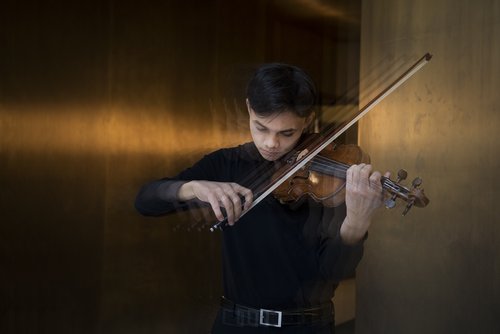 United Kingdom Menuhin Gstaad Festival 2023 [2]: Tchaikovsky, Brahms: Raphael Nussbaumer (violin); Gstaad Festival Amateur Orchestra / Kevin Griffiths (conductor). Gstaad Festival Tent, Gstaad, Switzerland, 6.8.2023. (CC)
United Kingdom Menuhin Gstaad Festival 2023 [2]: Tchaikovsky, Brahms: Raphael Nussbaumer (violin); Gstaad Festival Amateur Orchestra / Kevin Griffiths (conductor). Gstaad Festival Tent, Gstaad, Switzerland, 6.8.2023. (CC)

Tchaikovsky – Violin Concerto in D, Op.35 (1878)
Brahms – Symphony No.1 in C minor, Op.68 (1876)
The Gstaad Festival Amateur Orchestra is now in its 14th year, and in good health if this lunchtime (11.30am) concert was anything to go by. Two pot-boilers might have been on offer, but the freshness of youth ensured a bracing pre-lunch event. A nice touch, too, to acknowledge the two Ukrainian members of the orchestra prior to commencement.
The violinist Raphael Nussbaumer was born in 2006. He started early: his website tells us that ‘at his baptism, he was offered his first violin’. His first violin lesson was aged 4. Joining Philip Draganov’s class at the Zürich Conservatory two years later, he went on to win several competition prizes (so far). He has previously collaborated with the London-born conductor Kevin Griffiths in Mendelssohn’s Violin Concerto (in 2019). He is a born soloist: the Festival Tent in Gstaad is a huge space, and Nussbaumer filled it with ease. Occasionally his extreme upper register felt a bit wiry in timbre, but he is a fine technician, perfectly at ease with the many stoppings in the score, and clearly in alignment with Tchaikovsky. The first movement cadenza was mesmerising, and Nussbaumer is capable of some very pure harmonics. A special word for some of the members of the orchestra, particularly the superbly expressive principal oboe, and the principal flute for a lovely timbre.
The ‘Canzonetta’ is a violin song, and so it was here. Perhaps there was some ensemble problems within the woodwind department, and overall, the orchestra seemed a little unsettled at first in this central panel (in contrast, Nussbaumer was perfectly at home throughout). A dialogue between flute and clarinet later on, though, was cherishable. The finale felt somewhat low on voltage until the end, mitigated by Nussbaumer’s deep, somewhat smoky lower register.
Throughout, conductor Kevin Griffiths was hyperclear of beat, and fully attentive to his soloist. He clearly has a keen ear for texture as well as communicating well with his players. From 2011 until 2018, Griffiths was Principal Conductor and Artistic Director of the Collegium Musicum Basel; he is an annual visitor to Gstaad, He might be familiar to readers through his recordings; unsurprisingly he shows the same qualities of musical intelligence and razor-fine rapport with his soloist on a disc of Johann Stamitz Violin Concertos on the cpo label. His recording of Johann Brandl orchestral works has been reviewed on Music Web International (here), Griffiths’s website refers to an interest in historically-informed performance, which could explain his ability to delineate textures so keenly.
That was certainly something that was evident right from the off in Brahms’s First Symphony, with its throbbing C minor. Again, there were some fine woodwind contributions; as the first movement proceeded, though, there were some ragged edges that seemed to suggest the Tchaikovsky might have had the more rehearsal. Nevertheless. this was an intelligent realisation (tempo relationships carefully considered, the whole with an awareness of the music’s structure). The Andante sostenuto moved along nicely but was marred by a rather brusque ending; the third movement, Un poco allegretto e grazioso, was somewhat low-voltage (and included some sloppy trumpet contributions) and yet the finale boasted well-disciplined pizzicatos, with a well-judged accelerando; and the two horns with their primordial calls were magnificent (some splendid hairpins from the second player). If the very ending was, again, lacking in true excitement, there was much to admire here.
Colin Clarke